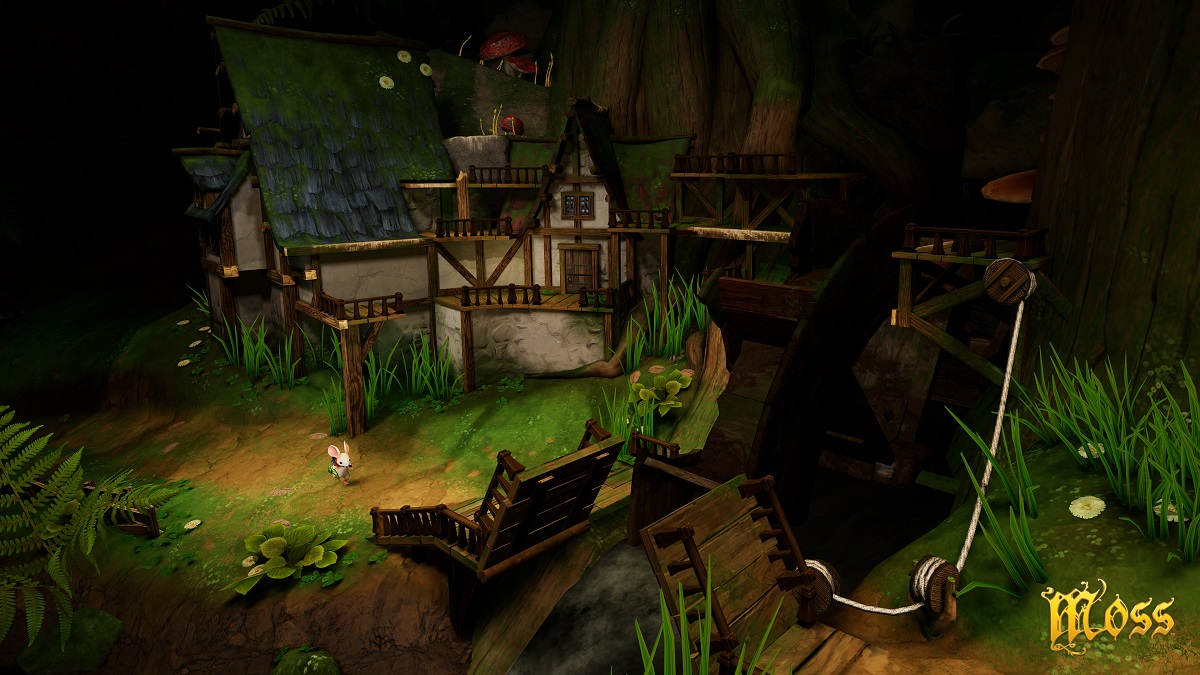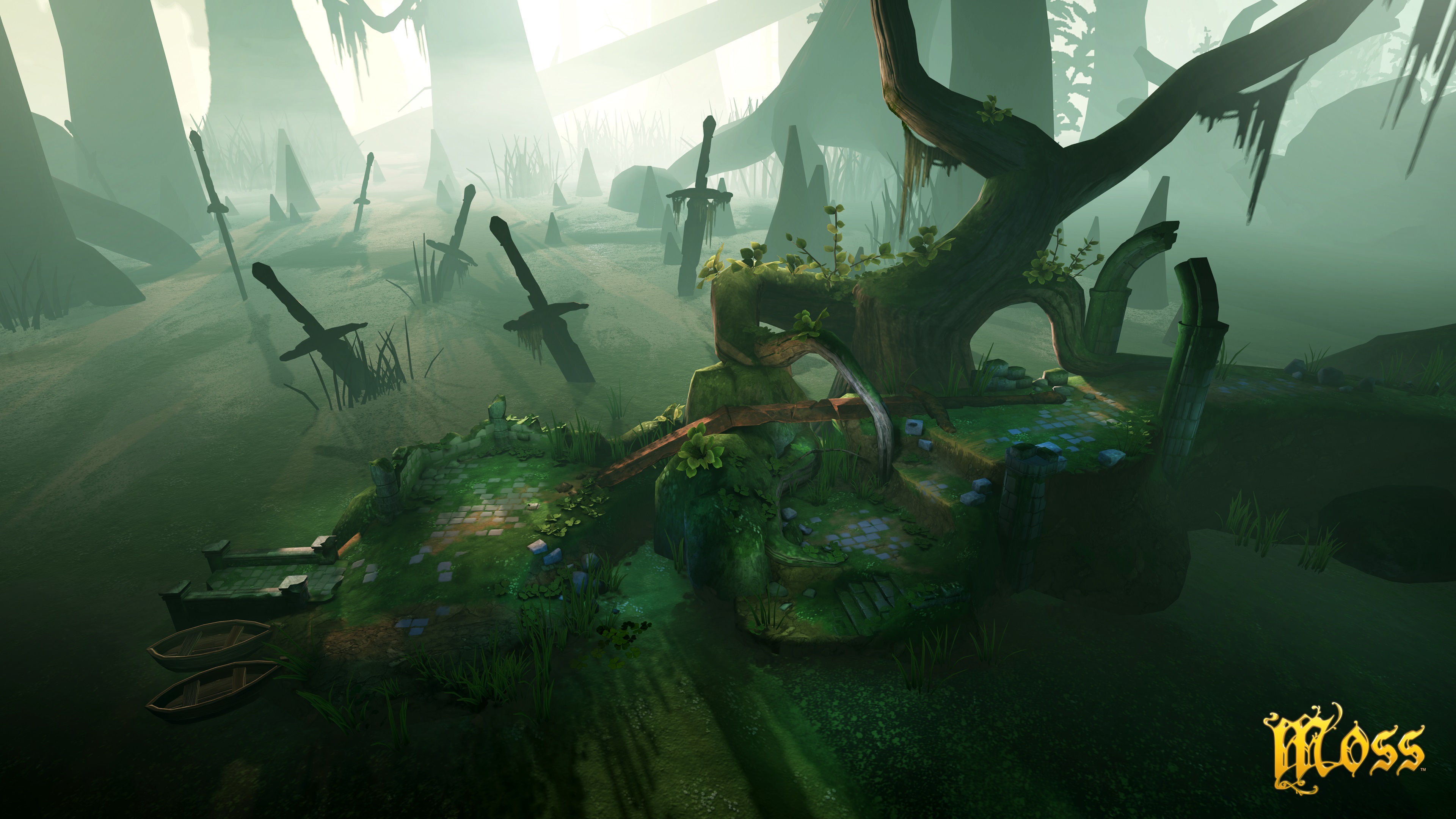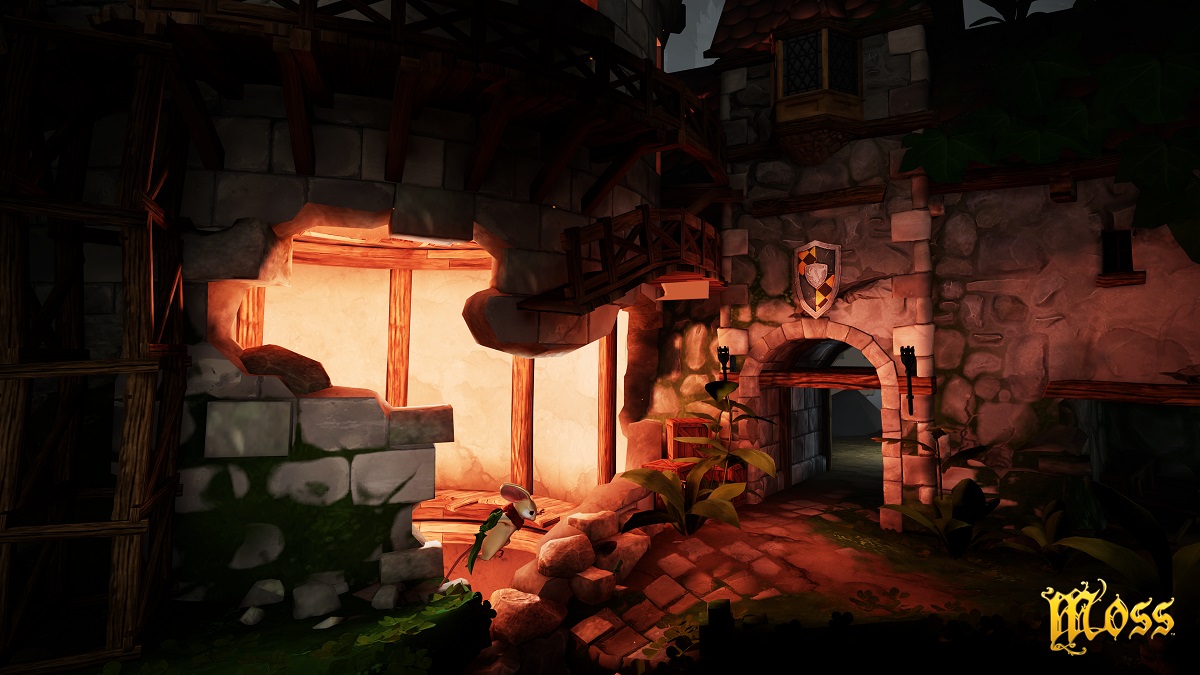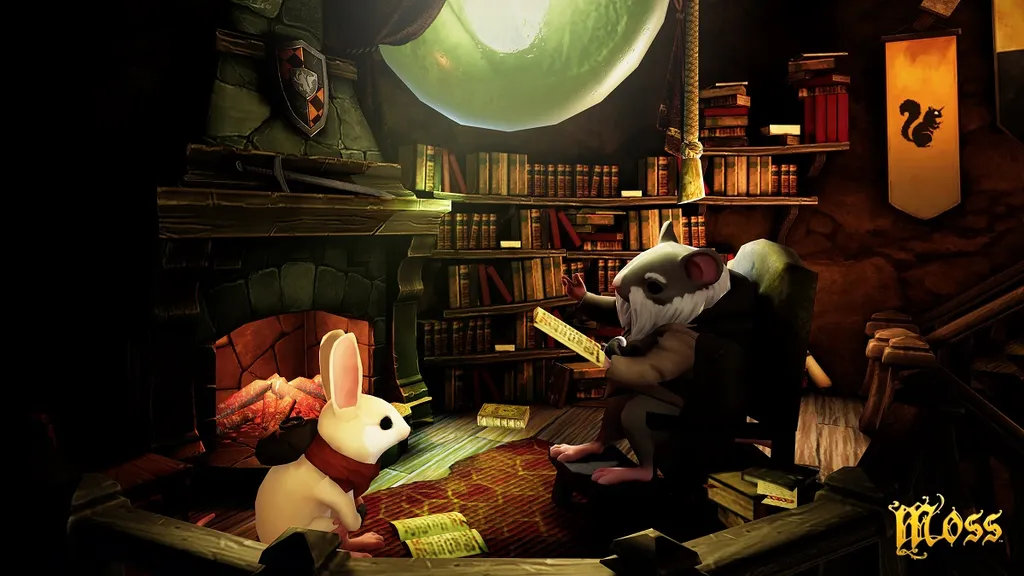Review Update for Rift and Vive: Luckily the PC port of Moss is just as wonderful as I’d hoped when I found out it was coming. The upgraded visual clarity is noticeable, especially in the environments themselves, and having a larger tracked space means I can more easily look and move around the environment without fear of losing tracking like I did with PSVR’s single camera.
Having both hands by way of motion controller support in Touch and Vive doesn’t make as big of a difference as you might think since the PS4’s DualShock 4 is already tracked and is included in several interactive puzzles and combat elements. However, the tracking quality is much better this time around, removing much of the frustrating caused by PSVR’s poor camera. There are now multiple save files as well.
All-in-all this is the exact same great game it was on PSVR. Moss is still excellent and still highly recommended. If you have both a PSVR and PC VR headset then you may as well just play the PC version for the enhancements alone.
Original Review: Moss is a remarkable game. Not just because of how good it is (and it’s quite good) but also because of the mere fact that it exists at all. The VR market is overrun with mature-leaning shooting games full of blood and gore and developers have an obsession with developing these games from the first-person perspective. If it doesn’t have motion controllers with full, smooth locomotion no one seems interested in playing. But Moss defies all of these expectations.
Moss is a third-person top-down isometric action-adventure-puzzle game featuring a tiny little mouse. There’s no blood, no gore, and very little combat to speak of throughout the entire adventure and you can only play it using a single DualShock 4 controller in your hands.
The past two years of covering VR games has led me to believe that games like this just weren’t “for” VR as a platform, but Polyarc has proved me wrong.
If you’ve played titles like Lucky’s Tale, Edge of Nowhere, or even Chronos, then you know there is a good bit of value to be found in third-person VR games. You lose a bit of presence typically in those other examples, but you gain a lot of perspective and scale. In the case of Moss, the developers have found a way to defy logic and marry all of that together.
The main character of the game is Quill, a tiny little white mouse, and she exists separately from your character, known as a “reader”. Everything in Moss is told through the pages of a storybook that’s recited to you between each of the game’s various chapters. During the moments of action you zoom into the pages and take control of Quill using your controller’s analog stick and buttons.
Given the obsession with motion controllers in VR currently it’s easy to forget that the DualShock 4 also has motion tracking built in with the light on the front of it. As a result, this is a major gameplay element in Moss.

Your controller is the bridge between the real world and Quill’s world. She will look up at you, acknowledging your presence, and even give you high fives after you complete particularly challenging segments. More than a few times she’d even communicate with sign language and point out things in the world for me to check out. Lucky’s Tale explored some of this a little bit, but that was mostly from a follow-along camera perspective. In Moss, you’re given real agency as a part of the game world.
Some segments let me look down at pools of water to see my mask-covered reflection gazing back. If Quill gets hurt I can reach out and sooth her pain to restore her to full health. If I’m feeling particularly affectionate, I can even pet her on the top of the head, between the ears, until she smiles. Using the small ball of light I can interact with areas of the world to push blocks, move obstacles, and even control enemies as well.
There’s a real sense of companionship that blossoms over the course of the game I feel confidently in saying is quite unlike anything else I’ve seen in VR yet. That lack of player agency was one of the biggest hurdles that games like Chronos were never able to clear, and it really shines through in Moss’ design philosophy.

And for the first time in a while, Moss feels like a distinctly PSVR game. Its use of the DualShock 4 controller is wonderful and fluid. You could theoretically replicate the effect on Rift with Touch just fine, or to a lesser degree, on Vive with the trackpad wands, but it wouldn’t feel quite the same.
Since Moss is a top-down third-person action-adventure-puzzle game one of the most immediate comparisons it draws is going to always be The Legend of Zelda and that’s for good reason. It’s a clearly communicated inspiration for the team and it shows in screenshots, trailers, and most especially once you dive into the world.
Like the old-school Zelda games from the 80s and 90s, Moss exudes an aura of discovery for each and every scene in the game. Aesthetically it channels that same sense of childlike wonder and from a design perspective it mimics a formula that’s always worked well for the Zelda games.

However, there is far less combat than what you might be used to this time around. The vast majority of Moss consists of Quill walking into a scene, you looking around to figure out what the puzzle wants you to do, killing a few enemies to clear the way or taking control of the enemies to solve the puzzle, and moving on. After a few of these scenes, there are usually one or two low-intensity scenes to break it up designed for you to mostly look around and appreciate the environment.
It’s a great pace that works really, really well. Every now and then you’ll come across a combat-heavy room and the fluidity of Quill’s animations really shines through. When you’re not chaining together her attacks, you can dodge out of the way before quickly diving back in. Many enemies can also be controlled as a way of defeating them (delaying their self-destruct explosion, for example) or to interact with the game world (moving the enemy onto a pressure-activated switch) which really amplifies the amount of gameplay variety.
Moss does a great job of mixing up the puzzles. At first they start out very simply, just moving blocks around, but quickly get much more complex. Eventually you’ll be exploring large multi-level environments with Quill and then controlling enemies with the motion tracking of your controller while also controlling Quill at the same time with your analog stick.
With this system, solving puzzles in Moss requires a new type of ambidexterity (moving my hands through 3D space while simultaneously moving my thumbs in precise circles on a 2D plane) that my hands aren’t used to.
It’s challenging and thought-provoking in a way that a non-VR game could never be.
Moss is the hidden gem the PSVR never knew it needed. From the first moment we played the game at E3 almost a year ago until we saw the closing credits roll, Quill’s adventure has captivated our hearts and minds. Moss strikes that perfect balance between tense, action-packed moments of combat with slow, methodical puzzles that require you to rethink the way you interact with video games through the power of VR. Polyarc has crafted one of PSVR’s most essential games to date.
Moss is available now exclusively for PSVR on the PSN Store. Read our Game Review Guidelines for more information on how we arrived at this score.


























